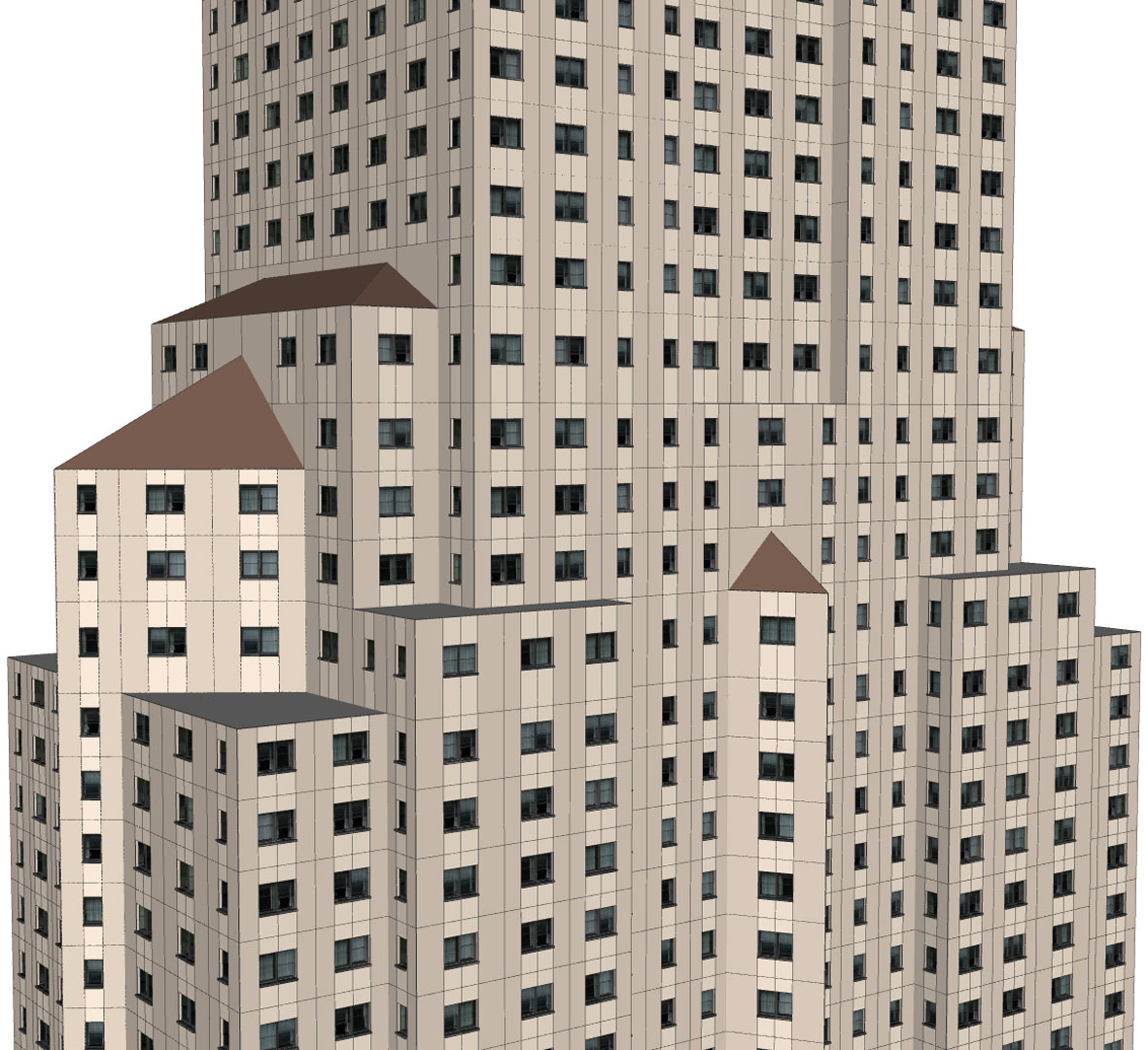“Procedural modeling of buildings” by Müller, Wonka, Haegler, Ulmer and Gool
Conference:
Type(s):
Title:
- Procedural modeling of buildings
Presenter(s)/Author(s):
Abstract:
CGA shape, a novel shape grammar for the procedural modeling of CG architecture, produces building shells with high visual quality and geometric detail. It produces extensive architectural models for computer games and movies, at low cost. Context sensitive shape rules allow the user to specify interactions between the entities of the hierarchical shape descriptions. Selected examples demonstrate solutions to previously unsolved modeling problems, especially to consistent mass modeling with volumetric shapes of arbitrary orientation. CGA shape is shown to efficiently generate massive urban models with unprecedented level of detail, with the virtual rebuilding of the archaeological site of Pompeii as a case in point.
References:
1. Aichholzer, O., Aurenhammer, F., Alberts, D., and Gaertner, B. 1995. A novel type of skeleton for polygons. Journal of Universal Computer Science 12, 12, 752–761.Google Scholar
2. Alexander, C., Ishikawa, S., and Silverstein, M. 1977. A Pattern Language: Towns, Buildings, Construction. Oxford University Press, New York.Google Scholar
3. Berg, M. D., Kreveld, M. V., Overmars, M., and Schwarzkopf, O. 2000. Computational Geometry. Springer-Verlag.Google Scholar
4. Ching, F. D. K. 1996. A Visual Dictionary of Architecture. Wiley.Google Scholar
5. Davis, M., Sigal, R., Weyuker, E. J., and Davis, M. D. 1994. Computability, Complexity, and Languages: Fundamentals of Theoretical Computer Science. Academic Press. Google ScholarDigital Library
6. Downing, F., and Flemming, U. 1981. The bungalows of buffalo. Environment and Planning B 8, 269–293.Google ScholarCross Ref
7. Duarte, J. 2002. Malagueira Grammar — towards a tool for customizing Alvaro Siza’s mass houses at Malagueira. PhD thesis, MIT School of Architecture and Planning.Google Scholar
8. Ehrig, H., Engels, G., Kreowski, H.-J., and Rozenberg, G. 1999. Handbook of Graph Grammars and Computing by Graph Transformation: Applications, Languages and Tools. World Scientific Publishing Company. Google ScholarDigital Library
9. Eppstein, D., and Erickson, J. 1999. Raising roofs, crashing cycles, and playing pool: applications of a data structure for finding pairwise interactions. In Proceedings of the 14th Annual Symposium on Computational Geometry, ACM Press, 58–67. Google ScholarDigital Library
10. Flemming, U. 1987. More than the sum of its parts: the grammar of queen anne houses. Environment and Planning B 14, 323–350.Google ScholarCross Ref
11. Havemann, S. 2005. Generative Mesh Modeling. PhD thesis, TU Braunschweig.Google Scholar
12. Hillier, B. 1996. Space Is The Machine: A Configurational Theory Of Architecture. Cambridge University Press.Google Scholar
13. Knuth, D. 1968. Semantics of context-free languages. Mathematical Systems Theory 2, 2, 127–145.Google ScholarCross Ref
14. Koning, H., and Eizenberg, J. 1981. The language of the prairie: Frank lloyd wrights prairie houses. Environment and Planning B 8, 295–323.Google ScholarCross Ref
15. Le Corbusier. 1985. Towards a New Architecture. Dover Publications.Google Scholar
16. Legakis, J., Dorsey, J., and Gortler, S. J. 2001. Feature-based cellular texturing for architectural models. In Proceedings of ACM SIGGRAPH 2001, ACM Press, E. Fiume, Ed., 309–316. Google ScholarDigital Library
17. Mäntylä, M. 1986. Boolean operations of 2-manifolds through vertex neighborhood classification. ACM Transactions on Graphics 5, 1, 1–29. Google ScholarDigital Library
18. March, L., and Steadman, P. 1974. The Geometry of Environment. MIT Press.Google Scholar
19. Měch, R., and Prusinkiewicz, P. 1996. Visual models of plants interacting with their environment. In Proceedings of ACM SIGGRAPH 96, ACM Press, H. Rushmeier, Ed., 397–410. Google ScholarDigital Library
20. Mitchell, W. J. 1990. The Logic of Architecture: Design, Computation, and Cognition. MIT Press. Google ScholarDigital Library
21. Parish, Y. I. H., and Müller, P. 2001. Procedural modeling of cities. In Proceedings of ACM SIGGRAPH 2001, ACM Press, E. Fiume, Ed., 301–308. Google ScholarDigital Library
22. Prusinkiewicz, P., and Lindenmayer, A. 1991. The Algorithmic Beauty of Plants. Springer Verlag. Google ScholarDigital Library
23. Prusinkiewicz, P., James, M., and Měch, R. 1994. Synthetic topiary. In Proceedings of ACM SIGGRAPH 94, ACM Press, A. Glassner, Ed., 351–358. Google ScholarDigital Library
24. Prusinkiewicz, P., Mündermann, P., Karwowski, R., and Lane, B. 2001. The use of positional information in the modeling of plants. In Proceedings of ACM SIGGRAPH 2001, ACM Press, E. Fiume, Ed., 289–300. Google ScholarDigital Library
25. Schmitt, G. 1993. Architectura et machina. Vieweg & Sohn.Google Scholar
26. Shubnikov, A. V., and Koptsik, V. A. 1974. Symmetry in Science and Art. Plenum Press, New York.Google Scholar
27. Sipser, M. 1996. Introduction to the Theory of Computation. Course Technology, Boston. Google ScholarDigital Library
28. Stiny, G., and Mitchell, W. J. 1978. The palladian grammar. Environment and Planning B 5, 5–18.Google ScholarCross Ref
29. Stiny, G. 1975. Pictorial and Formal Aspects of Shape and Shape Grammars. Birkhauser Verlag, Basel.Google Scholar
30. Stiny, G. 1980. Introduction to shape and shape grammars. Environment and Planning B 7, 343–361.Google ScholarCross Ref
31. Stiny, G. 1982. Spatial relations and grammars. Environment and Planning B 9, 313–314.Google ScholarCross Ref
32. Weyl, H. 1952. Symmetry. Princeton University Press.Google Scholar
33. Wonka, P., Wimmer, M., Sillion, F., and Ribarsky, W. 2003. Instant architecture. ACM Transactions on Graphics 22, 3, 669–677. Google ScholarDigital Library





